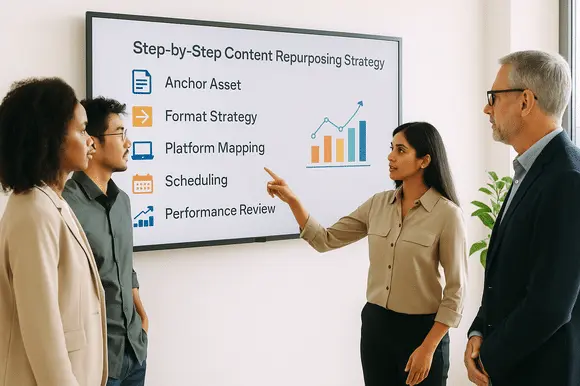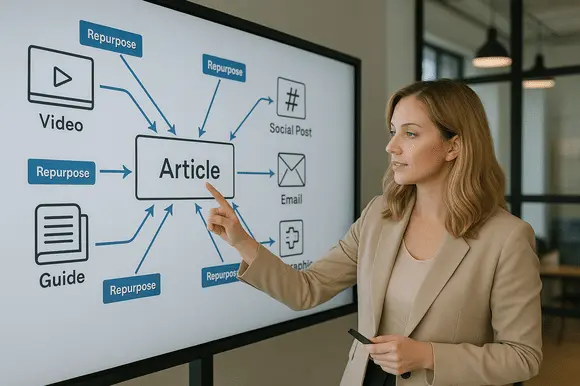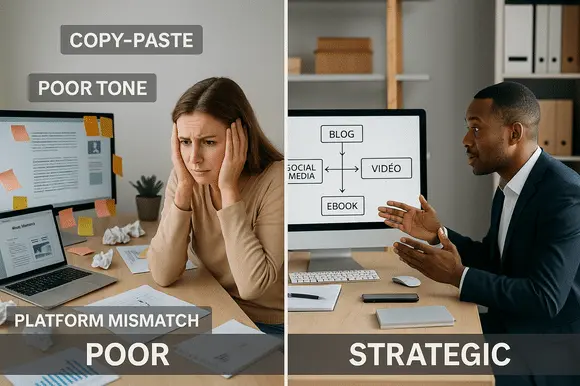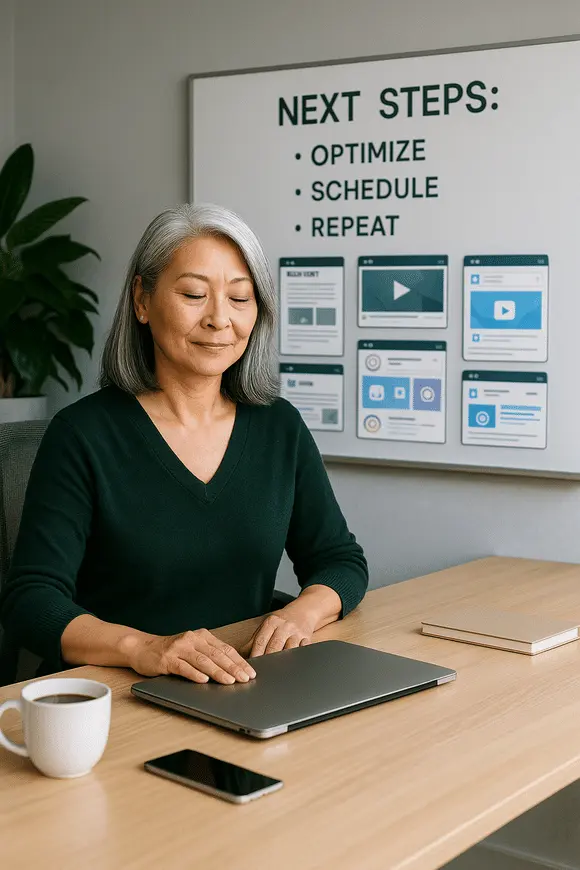Multi-Platform Content Repurposing
Transform Long-Form Content into Engaging Multi-Format Assets
In today’s digital landscape, the smartest marketers don’t just create more content — they create strategic systems that let one piece of content do the work of ten. That’s the power of content repurposing. Instead of constantly generating new material, you can transform a single blog post, guide, or video into platform-specific assets that extend your reach, reinforce your message, and multiply your results — all with a fraction of the effort.
This guide is designed for beginners looking to build a strong content distribution strategy without getting overwhelmed. Whether you’re managing a blog, social media calendar, or video channel, repurposing helps you work smarter — not harder — by maximizing every idea across multiple touchpoints. You’ll learn how to repurpose content step-by-step using simple tools, platform-specific techniques, and AI-driven workflows that make scaling your presence easier than ever.
What Is Multi-Platform Content Repurposing?

Multi-platform content repurposing is the process of taking one core piece of content — such as a blog article, podcast, or webinar — and reworking it into different formats optimized for various platforms. This could mean turning a blog post into a Twitter thread, a YouTube script, an Instagram carousel, or a downloadable PDF guide.
Unlike simple content recycling or copy-pasting, repurposing involves adapting the content’s structure, length, tone, and visual format to match each platform’s expectations and your audience’s consumption habits. The original message stays the same — but it’s reframed, resized, and reimagined to increase reach, engagement, and SEO value across channels.
By learning how to repurpose content intentionally, you create a content system that delivers consistent results without burning out your resources or audience. It’s not just about quantity — it’s about amplifying quality in strategic, scalable ways.
Why It Matters for SEO

Repurposing content doesn’t just save time — it improves your SEO. Each new format you create becomes an opportunity to reach new audiences, earn backlinks, and rank for related search terms. Instead of relying on a single page to carry your organic visibility, you spread relevance across platforms — all linked to your original content hub.
Here’s how strategic content repurposing benefits SEO:
- Increased keyword coverage: Repurposed formats allow you to naturally incorporate variations of your primary and secondary keywords, like “how to repurpose content” or “content distribution strategy.”
- Backlink opportunities: Guest posts, infographics, and video transcripts can all attract links from different audiences and websites.
- Improved user signals: Repurposed content encourages longer dwell time, return visits, and content engagement across your ecosystem — all factors that support ranking improvements.
- Better indexing: Distributing your message through multiple formats increases crawl frequency and visibility across search engine platforms like Google, YouTube, and even Pinterest.
When repurposing is built into your content distribution strategy, every channel contributes to your search authority. Instead of duplicating effort, you compound results by reinforcing the same optimized message in multiple, search-friendly ways.
Step-by-Step Strategy for Effective Content Repurposing

Implementing an efficient content repurposing workflow doesn’t require a massive team or complex tools — just a clear system and the right mindset. Below is a beginner-friendly step-by-step process to help you turn one piece of content into many, all while maintaining quality, consistency, and alignment with your content distribution strategy.
Step 1: Start with a High-Value Anchor Asset
Begin with a long-form piece of content like a blog article, podcast episode, webinar, or in-depth guide. This asset should cover a broad or detailed topic that can be broken down into smaller segments. Ensure that it's optimized for SEO from the start using your content repurposing plan. Your anchor asset should be evergreen when possible, providing long-term value that can evolve with your strategy.
Step 2: Identify Platform-Specific Opportunities
Review your anchor asset and determine how its content can be adapted to other platforms. Ask: Can a single point become a LinkedIn post? Can key stats become an Instagram graphic? Can the main message drive an email series? Match each idea with the format and tone of the intended platform. Consider audience behavior — people skim on Instagram, but seek depth on YouTube and LinkedIn.
Step 3: Outline Format Variations
Break your content into smaller parts and list out format-specific versions such as quote graphics, carousel posts, Twitter threads, newsletter segments, or short videos. This is where your knowledge of how to repurpose content comes into play — reshaping each idea without changing the core value. Repurpose in a way that emphasizes accessibility, attention span, and user intent on each channel.
Step 4: Create a Distribution Calendar
Organize your repurposed content into a publishing schedule. Spread the assets across several weeks or months to maintain visibility. This helps maintain momentum while supporting an ongoing content distribution strategy that keeps your audience engaged. Staggering content also improves SEO by signaling freshness and frequency to search engines.
Step 5: Track Performance & Refine
Monitor how each repurposed piece performs on its platform. Measure engagement, shares, click-through rates, and SEO metrics like backlinks or impressions. Use this data to adjust future repurposing efforts and identify what content formats resonate best with your audience. Over time, this feedback loop strengthens your content repurposing system and increases ROI.
This structured, repeatable process not only saves time but increases the reach and impact of every content asset. Whether you're adapting for video, email, or social media, strategic content repurposing empowers you to do more with less — and ensures your message lands everywhere it matters.
Platform-Specific Repurposing Examples

Effective content repurposing relies on understanding how different platforms consume and present content. What works on YouTube may fall flat on Instagram, and a successful LinkedIn post may not translate well to Twitter. To get the most out of your content distribution strategy, it’s essential to tailor your assets to the strengths and expectations of each platform. Below are beginner-friendly examples of how one anchor article can be transformed to fit multiple channels while preserving your brand’s voice and message.
LinkedIn:
Transform your anchor content into a professional insights post or series. Focus on thought leadership, data-backed points, and storytelling. Use the platform’s article feature for extended versions, or break content into multiple status updates to build topical authority over time. Incorporate hashtags, tag relevant professionals, and include a soft CTA to continue the conversation or drive traffic to the full article.
Instagram:
Turn core takeaways into carousel posts with bold headlines and visuals. Quotes, tips, and short stats can be transformed into visually engaging graphics. The caption can reinforce key points from the article in a condensed format, using clear calls to action or hashtags to extend reach. Add Stories or Reels to provide behind-the-scenes context or quick tips pulled from the original content.
Twitter / X:
Use short bursts of content from your original article to create a threaded conversation. Each tweet in the thread should stand alone with a specific insight or takeaway. You can also highlight quotes, questions, or tips that spark engagement and link back to the original content. Consider pinning a summary tweet or linking a visual to increase visibility within trending discussions.
YouTube:
Adapt the article into a script for an educational video, explainer, or walkthrough. Visual storytelling allows you to dive deeper into the content, supported by on-screen graphics or narration. Don’t forget to optimize the video title, description, and tags using the same keywords you used in the article. Use end screens and cards to drive viewers to related repurposed content or encourage comments for community feedback.
Email Marketing:
Repurpose sections of your article into standalone emails or a short series. Focus on one idea per email and include a clear takeaway. Emails can drive readers back to the original article or encourage engagement on another repurposed platform, creating cross-channel visibility. Use personalization and segmentation to increase open rates and make the content feel targeted and timely.
Blog or Guest Post:
Rewrite your original article into a new version with a different focus or for a different audience. You might expand on a single point, shift the tone, or introduce new examples. This approach supports your content repurposing plan while increasing backlink potential. Publishing guest posts also builds credibility and exposes your content to new audiences, amplifying your content distribution strategy even further.
Each platform offers a unique opportunity to reinforce your message from a fresh angle. By knowing how to repurpose content in these platform-specific ways, you create a stronger, more diverse content ecosystem that keeps your brand active and visible — everywhere your audience spends time.
AI Tools & Automation for Repurposing at Scale

As content needs grow, manual repurposing can become time-consuming and inefficient — especially when trying to maintain consistency across multiple channels. Fortunately, modern AI and automation tools make content repurposing easier, faster, and more scalable than ever. These tools help transform long-form content into multi-platform assets while preserving tone, SEO integrity, and brand alignment.
SEOBoostAI:
At the core of this process is SEOBoostAI’s integrated repurposing workflow. Built into the IACP system, it automatically restructures your original content into platform-specific formats like LinkedIn posts, Twitter threads, Instagram captions, and YouTube scripts. It ensures that your content distribution strategy remains consistent while maintaining keyword frequency and SEO compliance across all variations. SEOBoostAI also offers a Hybrid Multi-Canvas Expansion process that allows precise repurposing one section at a time — ensuring clarity and scalability without compromise.
ChatGPT:
Using structured prompts and templates, ChatGPT can quickly generate repurposed assets from a single source. Whether you need a summary, a video script, or an email draft, you can prompt ChatGPT to retain the core message while adapting format, length, and tone to suit different platforms. It's ideal for those learning how to repurpose content efficiently without sacrificing quality. With memory enabled, ChatGPT can also retain your brand tone and repurposing preferences, creating even greater consistency at scale.
Canva & Adobe Express:
For visual content, platforms like Canva allow you to turn quotes, statistics, or tips into branded graphics for Instagram, LinkedIn, or Pinterest. Templates make it easy to replicate your content across formats, and automation features like bulk resizing save significant time during production. Canva’s AI tools can now suggest layouts, align branding elements, and even auto-generate slideshows based on your anchor asset.
Descript & VEED:
For audio or video repurposing, tools like Descript convert podcast episodes or webinars into short-form clips, subtitles, and transcriptions that can be reused for video content or blog snippets. This is particularly useful when transforming interviews into multiple content formats at scale. Descript’s Overdub and screen recording features also allow you to re-record or annotate sections without restarting the entire production.
Scheduling & Automation Platforms:
Tools like Buffer, Hootsuite, and CoSchedule allow you to distribute repurposed content across multiple platforms with minimal manual effort. You can preload assets and stagger releases to create sustained visibility over time, all while analyzing performance to refine your content distribution strategy. Many of these tools offer AI-driven optimization, suggesting the best time to post or identifying top-performing content clusters for deeper repurposing.
When used together, these AI tools create a repurposing system that delivers consistent, search-optimized content across every channel. Whether you're a solo creator or scaling a content team, automation ensures your message is amplified — not duplicated — and that every repurposed asset reinforces your brand’s digital footprint. Embracing automation doesn’t replace creativity — it enhances it, allowing you to focus on strategy while AI handles the repetitive work.
Strategic Mapping: One Content → Many Assets

At the heart of smart content repurposing is the ability to extract multiple assets from a single anchor piece — not just randomly, but strategically. This process begins with understanding the structure and key ideas within the original content, then mapping those ideas to the most appropriate and impactful formats. This is where an organized content distribution strategy becomes essential, allowing you to plan, produce, and deploy content variations with clarity and purpose.
Here’s an example of how a single blog article can be repurposed into 10+ high-impact assets:
- Blog Post: The original long-form anchor asset
- LinkedIn Article: Reformatted into a professional insight post with added commentary
- Instagram Carousel: Visual tips extracted from subheadings or bullet lists
- YouTube Video Script: Repurposed as an educational walkthrough
- Email Series: Divided into 3–5 messages, each covering a single idea with actionable takeaways
- Twitter/X Thread: Converted into a short-form thread highlighting key takeaways or curated insights
- Infographic: Visual representation of the main process, steps, or supporting statistics
- Webinar Slide Deck: Expanded into a structured visual presentation for live delivery or recording
- Short-Form Video (Reels/Shorts): Scripted around one powerful insight or rapid-fire tips
- Podcast Segment: Turned into a discussion or interview-style episode based on core themes
- Lead Magnet or PDF Guide: Compiled from the blog’s most valuable sections, formatted for downloads
Advanced mapping also includes planning internal links, cross-referencing between assets, and scheduling distribution to stagger visibility. This level of intentionality increases SEO value and user engagement while reducing production time and friction. Each format becomes a node in your larger content distribution strategy — designed to reach people where they are and guide them toward deeper engagement.
By building your repurposing roadmap before you create a single asset, you're able to reverse-engineer content that’s built for scale from day one. With the help of tools like SEOBoostAI, these touchpoints are not only generated faster, but optimized to retain tone, context, and search performance across every variation. This is how to repurpose content like a strategist — with a plan that connects the dots from awareness to action.
Common Mistakes to Avoid When Repurposing

While content repurposing offers massive benefits, it’s easy to dilute your results if the process is rushed, unstructured, or disconnected from your overall goals. To make the most of your content distribution strategy, avoid these common pitfalls that often hinder performance and lead to inconsistent branding or wasted effort.
1. Copying Without Adapting:
Repurposing is not the same as duplicating. Simply copying a blog paragraph into a social caption or video script without adjusting tone, structure, or context will feel robotic and disengaged. Each format demands its own style — take time to shape content for the platform it’s published on. This includes trimming length, rewriting intros, and changing visual presentation to suit the attention span and expectations of that specific audience.
2. Ignoring Platform Behavior:
Every platform has a unique rhythm. What works on Twitter may not work on Instagram. Neglecting user expectations — such as visual design on Instagram or brevity on TikTok — reduces impact. Repurpose content in ways that align with how users engage on each channel. Study platform trends, content types, and audience interaction styles before publishing.
3. Losing SEO Integrity:
Repurposing without maintaining keyword placement, internal links, or structured formatting can erode the SEO value of your anchor content. Every version should preserve — or enhance — the content’s search optimization. Smart content repurposing strengthens rankings, not weakens them. If you’re creating blog spin-offs or landing pages, double-check keyword density and metadata to ensure consistency.
4. Overextending Without Purpose:
Trying to show up on every platform without a clear message or goal can fragment your efforts. Each asset should have a strategic intent: build awareness, drive traffic, encourage engagement, or support conversions. Focus on channels where your audience actually spends time. A refined content distribution strategy prioritizes quality over quantity — even if that means repurposing for fewer platforms more effectively.
5. Failing to Track Results:
If you don’t monitor how repurposed content performs, you can’t improve it. Use metrics to analyze engagement, SEO impact, conversion behavior, and platform performance. This insight allows you to refine your approach and increase returns. Treat repurposing as an ongoing feedback loop — not a one-time activity.
Conclusion & Next Steps

Effective content repurposing is not about doing more work — it’s about doing smarter work. By transforming one high-quality piece into multiple targeted assets, you multiply reach, extend content life, and streamline your visibility strategy without sacrificing consistency or quality. Whether you're publishing to LinkedIn, Instagram, YouTube, or email, the core message remains intact — just reimagined for each audience and platform. Every adaptation becomes another opportunity to reinforce your brand’s voice and meet your audience where they already are.
If you’re just starting to build a content distribution strategy, begin with one strong piece of content. Use it as your anchor, then follow the mapping and platform-specific techniques outlined in this guide. Choose two or three channels where your audience is already active, and focus your efforts there first. Prioritize quality over quantity. Refine each asset before expanding into new platforms — and always consider how each version supports your brand’s broader narrative.
SEOBoostAI makes this process easier by guiding you step-by-step through the IACP system. From writing your long-form anchor asset to converting it into optimized short-form content, it automates the repurposing process while preserving SEO structure, brand tone, and cross-platform adaptability. It also ensures that your repurposed content meets best practices for how to repurpose content while staying compliant with current search engine expectations.
Mastering the art of strategic repurposing turns every idea into a multi-format content engine. Done right, your content doesn’t just appear once and fade — it lives on across platforms, attracts new audiences, and strengthens SEO over time. With the right mindset and systems in place, you’ll create a content ecosystem that grows with every piece you publish — and every platform you serve.
Your next step? Start with one article. Repurpose it into three formats using what you’ve learned. Then analyze, adjust, and repeat. Track engagement, optimize based on performance, and refine your system as you go. With each cycle, your repurposing strategy becomes more efficient, your results more consistent, and your message more powerful — across every corner of your digital presence.
Frequently Asked Questions

What is content repurposing?
Content repurposing is the process of taking an existing piece of content — such as a blog post, podcast, or webinar — and adapting it into multiple new formats for different platforms. This could include turning a blog into a YouTube script, a podcast segment, an Instagram carousel, or an email mini-series. The goal is to extend the lifespan and reach of your content without recreating it from scratch, while maintaining SEO value and brand alignment.
How do I start repurposing my content?
Begin by selecting a strong, evergreen anchor asset that provides real value to your audience. Break it into modular parts such as tips, statistics, or key takeaways. Then, identify where your audience spends time and adapt those segments into format-specific content such as LinkedIn posts, Instagram graphics, or email messages. Use tools like SEOBoostAI to automate the workflow while following a structured content distribution strategy.
What are the best platforms to repurpose content on?
The best platforms for content repurposing depend on your industry and where your target audience is most engaged. LinkedIn is ideal for thought leadership, Instagram for visual storytelling, YouTube for in-depth tutorials, and Twitter/X for bite-sized insights. Email remains effective for nurturing leads and maintaining consistent communication. Focus on 2–3 platforms to start, then expand as your system becomes more efficient.
Does content repurposing help with SEO?
Yes, when executed strategically. Repurposed content can increase your search visibility by driving backlinks, improving user engagement signals, and expanding keyword coverage across platforms. Each version of your repurposed content should include proper metadata, keyword integration, and links to your anchor asset. A smart content repurposing plan reinforces your site’s authority and feeds into a long-term content distribution strategy.
Can AI help automate content repurposing?
Absolutely. AI tools like SEOBoostAI and ChatGPT can help convert long-form content into optimized short-form assets for various platforms. They ensure consistent tone, proper formatting, and SEO alignment across all outputs. When combined with design tools like Canva and scheduling platforms like Buffer or CoSchedule, you can build a complete system for repurposing at scale with minimal manual effort.
